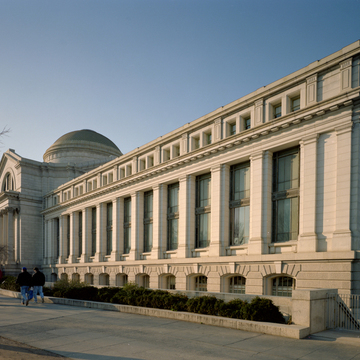The National Museum of Natural History was conceived as part of the McMillan Plan, which aimed to improve the city’s park system and eliminate the Mall's Victorian landscaping in favor of a Neoclassical design for the Mall and its surrounding buildings. The museum was a signature project intended to set an example for other Beaux-Arts buildings. The local architectural firm of Hornblower and Marshall designed the layout for the nearly one-million-square-foot structure. When finished, it was the second largest building in Washington after the Capitol Building. In addition to exhibiting collections, the Museum is home to the largest group of scientists dedicated to the study of natural and cultural history in the world.
The architects focused their design on the central octagon, an advanced system of fireproof construction, and spacious exhibition and storage areas. Although the white granite-clad exterior of the building is a stereotypical treatment of the four-story Beaux-Arts institutional envelope, its proportional treatment and sunken basement control the mass of a building covering 4 acres. The adoption of Charles McKim's suggestion of a dome inspired by the Roman Pantheon predicated a Corinthian portico with elaborate capitals derived from the Temple of Jupiter Stator in Rome. The central dome is buttressed by four extended gables broken by thermal windows, a motif frequently used by McKim, Mead and White. An octagonal version of such a dome was simultaneously under construction at the Army War College. The dome covers the building's best architectural feature, a three-story irregular octagon with a Guastavino tile vault, modeled on that of McKim, Mead and White's Low Library at Columbia University (1898). The Natural History Museum's octagon has doors and loggias set within short pier walls that make the transition from the octagon to the circular dome. Longer walls that run between them contain triple-tiered balconies for ease of circulation on each level. Three levels of columns are not the usual Doric below Ionic below Corinthian, possibly because the bottom two stories (Ionic above Doric) are the same height, and the third story (Ionic) is shorter. Indiana limestone walls and variegated marble columns were a concession to architectural grandeur for the building's main space; the remaining interior walls are covered with glazed terra-cotta tiles.
Steel frame construction allowed for three 116-foot-wide skylit main halls with no permanent interior walls, thus maximizing flexibility of exhibition areas. The second-floor north hall on the main axis, the present Hall of Dinosaurs, is the only area today where this dramatic span is still visible. The diameter of the octagonal hall is 81 feet 6 inches along its main axis. The dome's diameter is 75 feet and its total height is 165 feet.
In the early 1960s, the museum added two new wings to accommodate expanding collections, thus bringing the total square footage to just under two million. Major hall renovations began in 2003 with the Hall of Mammals and in 2014 the Dinosaur Hall closed for a $48 million renovation, completed in 2019. As the most visited natural history museum in the world, the institution requires regular active maintenance.
References
“Architectural History of the National Museum of Natural History, 1904.” Smithsonian Institution Archives. Accessed May 11, 2020. https://siarchives.si.edu/.








